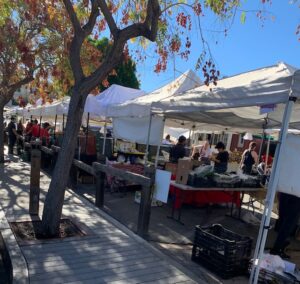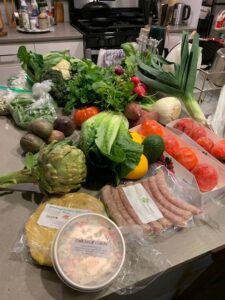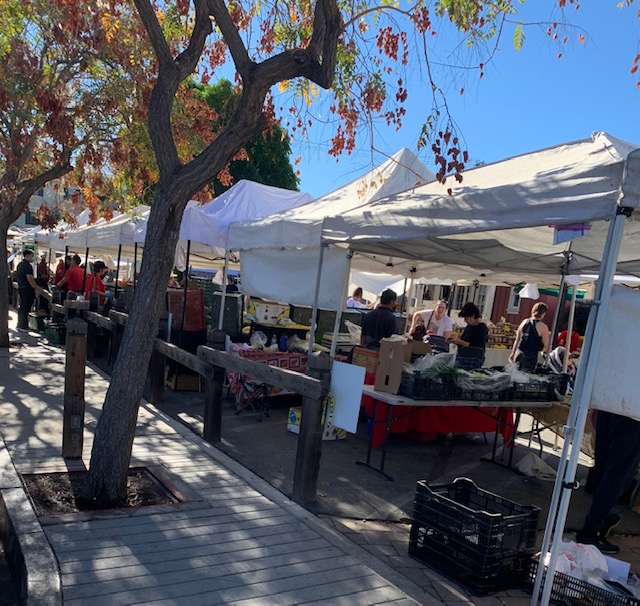 Explore Your Local Market
Explore Your Local Market
In the last decade, millions of people have altered their buying habits and now purchase some food from CSAs, farmers’ markets, and grocery stores that specialize in locally grown, unsprayed, and unprocessed produce and grains, sustainable wild-caught fish, and happy chickens.
I’m one of them.
CSAs
When I lived in Santa Cruz, I had the good fortune to live a half-mile from our local Saturday farmer’s market. At first, I would walk down for coffee with a friend. We soon began buying breakfast from a food vendor and talking while we enjoyed our meal and the music that often accompanies these events. Several children usually congregated in front of the musicians, and they became part of the entertainment and the wonderful ambiance that I soon began to associate with farmers’ markets everywhere.
After my friend and I parted, I would peruse the rest of the booths. At first, I just bought flowers and some fresh in-season fruit. Gradually I increased the amount of food I bought, enjoying the wide selection of in-season fruits and vegetables, some of which were unfamiliar to me. Now I pull a folding shopping cart so I can fill three or four large shopping bags with organically grown vegetables, fruit, eggs, chicken, and wild-caught fish. I look forward to the market each week, and so does my 5-year-old granddaughter, who often accompanies me. It has become a highlight of our week. The smells and sounds draw us in; we explore the honey booth, with charming beeswax candles and honey-filled straws, the pastry booth that we can smell two rows away, and the myriad of microgreens and sprouts grown from peas, mung beans, sunflowers, radish seeds, and clover.
In my new life, I drive five miles to the market and pay to park, but that too is part of the routine – handing over four $1.00 bills and chatting with the friendly woman who monitors the parking lot.

This Week’s Haul
With a refrigerator overflowing with fresh vegetables, it’s easy to include a variety of veggies in each meal and to perk up my daily lunch salad with colorful and interesting combinations of greens, roots, fruit, nuts, and sprouts.
Perk up Your Salads
I’ve been told by friends that making salads is “too much trouble,” or “takes too long.” I too have had periods in my life when the preparation of a healthy salad has felt like too much in the rush of things, yet once it was prepared and on the table, I was glad I took the time. The secret to making it less of a burden is to wash and pre-cut the vegetables and greens early in the day and store them in sealed containers, ready to put together just before eating. Since I now live alone, I sometimes make enough for two or three days.
Use a Variety of Greens
I like to use a variety of greens in my salads. Anything that is leafy and green is fair game (almost — don’t use rhubarb leaves; they’re poisonous). Today I tear pieces of romaine, butter, and red leaf lettuce, spinach, endive, chicory, and sorrel into the bowl. I have also explored using Swiss chard, kale, mustard greens, beet leaves, celery tops, parsley, cilantro, mint, and bok choy. Taste the leaves. If they are bitter, make the pieces tiny, or use less of them. In her classic book, Let’s Cook It Right, Adele Davis warned against cutting the greens with a metal knife; the brown edges you will find an hour or two later result from oxidation, and signal vitamin loss. Tear the leaves instead, or cut them with a serrated plastic knife, and they will hold their color and vitamins longer.
I know that it’s possible to purchase mixed greens at most grocery stores, and even farmers’ markets sometimes pack greens that way because customers request it. But they can never be as fresh as those I prepare myself, and they have been handled by several people on the way to my sink. It only takes five minutes to tear your own greens and wash and dry them; to me, it’s not worth the extra risk.
After putting a goodly number of greens into your salad bowl, start decorating them with colorful vegetables. We all know about tomatoes, radishes, and celery, but you can be more creative than that. Select vegetables by the season. In spring and summer, my salads are vibrant with flavor-rich heirloom tomatoes, fresh peas and green beans, tender green onions, lemon cucumber slices, and fresh fruit. In the winter, I add blanched broccoli or cauliflower, raw daikon, jicama, turnips, and parsnips. Daikon is a giant Japanese radish, sometimes hot, always tasty. Jicama hails from south of the border and is sweet and moist —sliced into small squares a quarter of an inch thick it provides a real variety of flavor for your salad. Turnips and parsnips usually are in the category of regional vegetables people out of the region don’t think they like, but you might be surprised if you try them raw.
Other possibilities for salad vegetables are mushroom slices, cooked asparagus, bell pepper strips and carrots, sliced or chopped, and cooked celeriac. Unless you have small children at your table or are struggling with false teeth, avoid grating raw vegetables into the salad bowl. Grating creates a lot of surface area, and vitamin loss occurs along the exposed surfaces. Vitamin C, bioflavonoids, and the B vitamins are lost in water, and in air, vegetables lose Vitamins A, C, and E. The more surface area, the greater the loss.
Try to get your salad ingredients as fresh as possible. Along with a weekly trip to the farmers’ market, grow a few varieties of leaf lettuce in a window box or on your deck or patio, along with basil, marjoram, and lemony-tasting sorrel. Harvest just as much as you need for each meal. Wash and dry your greens and refrigerate them right away. Vitamin loss is slowed in low temperatures. Wash the vegetables in cold water, but don’t soak, or the vitamins will go down the drain. Dry thoroughly, using either rough towels, paper towels, or centrifugal action. Swinging your greens in a net bag will dry them effectively if you don’t have a salad spinner. If you don’t plan to serve them immediately, refrigerate everything again in airtight containers. This will provide the crispest, tastiest, and most vitamin-rich selection for your table.
Coat with Oil?
Adelle Davis said to apply preservative-free unrefined oil to your salad, tossing to coat each leaf and vegetable, before adding herbs, spices, or acid (lemon juice or vinegar) to the mix. The reason for this is that if moisture is added first, the oil will not adhere, and if the oil does not adhere evenly, any herbs that you add will clump. Another reason for coating everything with oil is to seal out the vitamin-destroying moisture and air.
“I am watching my weight. I would NEVER coat my salad greens with oil!” remarked one of my friends when I was about to dress the salad at our meal. I explained that salad greens benefit from being lightly coated with oil before being submitted to the caustic effects of acids such as lemon juice or vinegar. I also reminded her that a teaspoon of oil contains only about 40 calories.
Seven of the top ten leading causes of death in the United States are linked to chronic diseases. Eating a diet rich in fruits and vegetables can help reduce the risk of heart disease, Type 2 diabetes, some cancers, and obesity. Frozen, canned, and dehydrated vegetables fall short of the flavor and texture of the fresh items, and learning to cook fresh vegetables properly will make them more appealing.
Purchasing vegetables from a farmers’ market or grocery store with a well-stocked organic vegetable section will change your life. I encourage you to locate a market near you and visit it with a friend. Bring some cash and a shopping bag. Buy at least one unfamiliar vegetable each time you shop. Ask the vendor how to prepare it.

Watermelon Juice at the Calabasas Farmers’ Market
Shopping at a farmers’ market is as good as going to cooking school.
Marlene Anne Bumgarner writes primarily about food, families, and traditions. Her 2020 memoir, Back to the Land in Silicon Valley, is about raising children, animals, and vegetables on a rural plot of land in the 1970s. Organic Cooking for (not-so-organic ) Families will be out in the spring. Her next project is a book about Grandparenting.
Share this post




Thanks Marlene. You’re inspiring me to kick up my salads a notch or two!
Glad to hear it! Your inspiration has had me baking pies and making English muffins, so I guess this is my contribution to your culinary efforts.
I loved reading your article on your shopping excursions at Farmer Markets, making salads, etc. I assume that picture of the darling 5-year-old sipping watermelon juice is your sweet granddaughter.
Your writing is captivating and full of delicious visuals!
Thank you, Patricia. Yes, that is indeed my grandaughter. And I very much appreciate your comments about my post!
I enjoyed your focus on making salads more interesting! I appreciate your advice about adding oil to greens first, before vinegar or lemon juice. I would add that I like to add a handful of toasted sesame seeds – that extra crunch satisfies me!
What a great idea, Gabrielle! I sometimes add sunflower seeds or toasted walnuts.